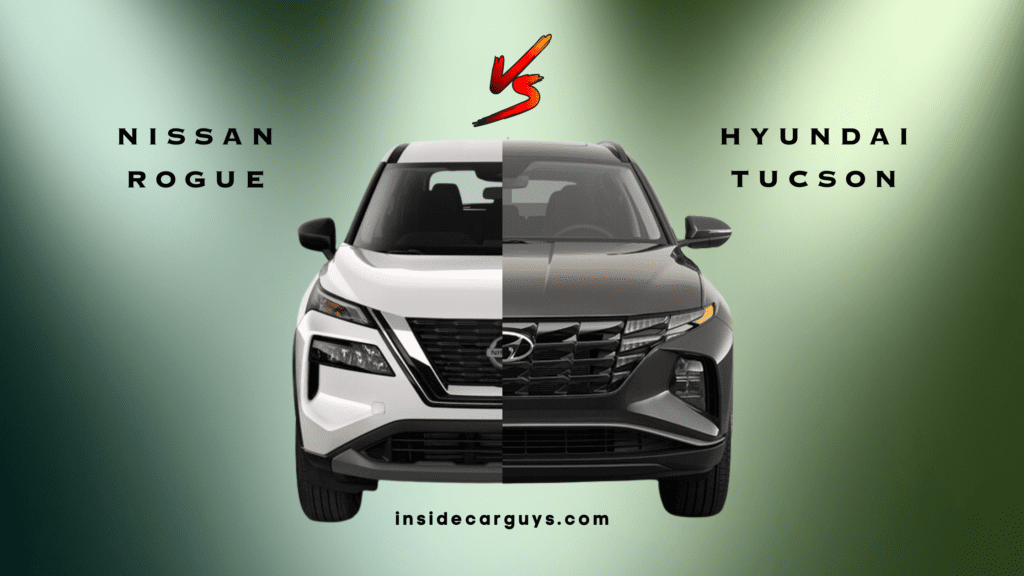In a world filled with compact SUVs vying for attention, the 2023 Nissan Rogue and Hyundai Tucson stand out as two of the most desirable options. Both vehicles have made a name for themselves with their stylish designs, impressive performance, and abundant features. But which of these SUVs should you choose?
In this in-depth comparison, we’ll take a closer look at both the Rogue and the Tucson, examining their unique offerings and highlighting the key factors that set them apart. By the end of this article, you’ll have a better understanding of what each vehicle brings to the table and be better equipped to make an informed decision.
Exterior Design:
The Nissan Rogue sports a bold, dynamic look that captures attention on the road. Its distinctive V-motion grille, sharply designed LED headlights, and aggressive body lines give it a muscular and athletic stance. The Rogue’s floating roof design adds a unique touch, while the available 19-inch alloy wheels provide both style and substance.
The Hyundai Tucson features a striking design, thanks to its cascading grille, sharp-edged LED headlights, and geometrically-inspired body lines. The Tucson has a slightly more angular appearance compared to the Rogue, giving it a futuristic and sophisticated feel. Its eye-catching 19-inch alloy wheels and chrome accents further enhance its visual appeal.
Interior Design:
The interior of the 2023 Nissan Rogue is focused on providing a comfortable and upscale experience for its occupants. The cabin features high-quality materials, including soft-touch surfaces and available leather seating. The dashboard is intuitively designed, with a touchscreen infotainment system taking center stage, accompanied by an available 12.3-inch digital instrument cluster. Ambient lighting and an available panoramic sunroof add to the overall sense of luxury.
The Hyundai Tucson offers a well-appointed interior, with a modern and minimalist design. The cabin features high-quality materials, including available leather seating and soft-touch surfaces. The Tucson’s dashboard is sleek, with a large touchscreen infotainment system and a digital instrument cluster available on higher trims. The available panoramic sunroof and ambient lighting further enhance the cabin’s inviting atmosphere.
Seating:
The Nissan Rogue provides comfortable seating for up to five passengers. The front seats are supportive and well-cushioned, with available power adjustments, heating, and ventilation. The second-row seats offer ample legroom and headroom, with an available sliding and reclining function for added comfort. The Rogue also features Nissan’s innovative Zero Gravity seats, designed to reduce fatigue on long drives.
The Hyundai Tucson seats up to five passengers as well. Its front seats are comfortable and supportive, with available power adjustments, heating, and ventilation. The second-row seats provide generous legroom and headroom, with available heated seats for added comfort. While the Tucson lacks the Zero Gravity seat technology, its seats remain comfortable for extended periods.
Storage:
The Nissan Rogue excels in terms of storage space, with a total cargo capacity of 74.1 cubic feet when the second-row seats are folded down. The Divide-N-Hide cargo system allows for versatile storage options, while additional compartments provide even more storage solutions. The Rogue’s hands-free liftgate makes loading and unloading items a breeze.
The Hyundai Tucson offers slightly less cargo space, with a total capacity of 70.9 cubic feet when the second-row seats are folded down. The Tucson features an adjustable cargo floor, providing additional storage options. Its hands-free liftgate also simplifies loading and unloading.
Performance:
The Nissan Rogue comes standard with a 2.5-liter four-cylinder engine, producing 181 horsepower and 181 lb-ft of torque. This engine is paired with a continuously variable transmission (CVT) that ensures smooth and efficient performance. Front-wheel drive is standard, while an available all-wheel-drive system offers enhanced traction and handling.
The Hyundai Tucson comes standard with a 2.5-liter four-cylinder engine, generating 187 horsepower and 178 lb-ft of torque. This engine is mated to an eight-speed automatic transmission, delivering a smooth and responsive driving experience. Like the Rogue, front-wheel drive is standard, and an all-wheel-drive system is available for improved traction and handling.
Fuel Efficiency:
The Rogue is efficient for its class, with an EPA-estimated fuel economy rating of 27 mpg in the city and 35 mpg on the highway for front-wheel-drive models. All-wheel-drive models see a slight decrease in efficiency, with an EPA-estimated 26 mpg city and 33 mpg highway.
The Tucson also boasts competitive fuel efficiency, with front-wheel-drive models achieving an EPA-estimated 26 mpg city and 33 mpg highway. All-wheel-drive models see a minor reduction in efficiency, with EPA estimates of 24 mpg city and 29 mpg highway.
Safety:
The Nissan Rogue comes standard with a comprehensive suite of advanced safety features, including forward collision warning, automatic emergency braking, pedestrian detection, lane departure warning, and blind-spot monitoring. The Rogue has earned a 5-star overall safety rating from the National Highway Traffic Safety Administration (NHTSA) and is a Top Safety Pick by the Insurance Institute for Highway Safety (IIHS).
The Hyundai Tucson offers an extensive array of safety features, such as forward collision warning, automatic emergency braking, pedestrian detection, lane-keeping assist, and blind-spot monitoring. The Tucson has been awarded a 5-star overall safety rating by the NHTSA and is also an IIHS Top Safety Pick.
Trim Levels:
The Nissan Rogue is available in four main trim levels: S, SV, SL, and Platinum. Each trim offers a progressively more upscale and feature-packed experience, with options like ProPILOT Assist, a head-up display, and a Bose premium audio system available on higher trims.
The Hyundai Tucson comes in four trim levels as well: SE, SEL, N Line, and Limited. Each trim level adds more features and options, such as a 10.25-inch touchscreen infotainment system, Harman Kardon premium audio system, and Hyundai’s Blue Link Connected Car services on higher trims.
Pricing:
The Nissan Rogue has a starting price of around $26,000 for the base S trim, while the range-topping Platinum trim starts at around $37,000. Additional options and packages can increase the price, but overall, the Rogue offers a competitive value in its segment.
The Hyundai Tucson starts at a slightly lower price, with the base SE trim starting at around $25,000. The top-of-the-line Limited trim begins at approximately $36,000. As with the Rogue, additional options and packages can affect the final price, but the Tucson represents a strong value proposition in the compact SUV market.
Key Differences:
While both the 2023 Nissan Rogue and Hyundai Tucson are strong contenders in the compact SUV market, there are several key differences between these vehicles that buyers should consider when making their decision.
Interior Design:
The Rogue’s interior is focused on providing a comfortable and upscale experience, with available features like ambient lighting and a panoramic sunroof. The Tucson’s interior also offers a well-appointed and inviting atmosphere but adopts a more modern and minimalist design.
Seating:
Nissan’s innovative Zero Gravity seats, designed to reduce fatigue on long drives, are a standout feature of the Rogue. While the Tucson also provides comfortable and supportive seating, it does not offer this unique seat technology.
Fuel Efficiency:
The Nissan Rogue achieves a higher fuel efficiency rating, with EPA-estimated 27 mpg city and 35 mpg highway for front-wheel-drive models. The Tucson has a slightly lower rating of 26 mpg city and 33 mpg highway for its front-wheel-drive models.
Pricing:
The Hyundai Tucson has a slightly lower starting price, with the base SE trim starting at around $25,000, compared to the Nissan Rogue’s base S trim, which starts at around $26,000. However, both vehicles offer competitive value within their segment.
Final Thoughts:
After comparing the 2023 Nissan Rogue and Hyundai Tucson across various aspects, it’s clear that both vehicles have a lot to offer in the competitive compact SUV market. While each SUV has its strengths and unique features, the choice ultimately comes down to personal preferences and priorities.
The Nissan Rogue excels in comfort and cargo capacity, while the Hyundai Tucson stands out for its futuristic design and slightly lower starting price. By considering your specific needs, preferences, and budget, you’ll be able to determine which of these capable compact SUVs is the ideal choice for you.
Features Breakdown:
Nissan Rogue:
- Exterior Design:
- Bold and athletic look
- V-motion grille
- Sharply designed LED headlights
- Floating roof design
- Available 19-inch alloy wheels
- Interior Design:
- Comfortable and upscale experience
- High-quality materials
- Intuitive dashboard layout
- Touchscreen infotainment system
- Available 12.3-inch digital instrument cluster
- Ambient lighting and available panoramic sunroof
- Seating:
- Comfortable seating for up to five passengers
- Supportive front seats with available power adjustments, heating, and ventilation
- Ample second-row legroom and headroom
- Innovative Zero Gravity seats
- Storage:
- 74.1 cubic feet of cargo capacity with second-row seats folded down
- Divide-N-Hide cargo system for versatile storage
- Hands-free liftgate
- Performance:
- 2.5-liter four-cylinder engine with 181 horsepower and 181 lb-ft of torque
- Continuously variable transmission (CVT)
- Comfortable and composed ride
- Standard front-wheel drive, available all-wheel drive
- Fuel Efficiency:
- EPA-estimated 27 mpg city and 35 mpg highway (FWD models)
- EPA-estimated 26 mpg city and 33 mpg highway (AWD models)
- Safety:
- Comprehensive suite of advanced safety features
- 5-star overall safety rating from NHTSA
- IIHS Top Safety Pick
- Trim Levels:
- S, SV, SL, and Platinum trims available
- Progressive increase in features and options
- Pricing:
- Base S trim starts at around $26,000
- Range-topping Platinum trim starts at around $37,000
Hyundai Tucson:
- Exterior Design:
- Futuristic and angular appearance
- Cascading grille
- Sharp-edged LED headlights
- Geometrically-inspired body lines
- Eye-catching 19-inch alloy wheels and chrome accents
- Interior Design:
- Modern and minimalist design
- High-quality materials
- Sleek dashboard layout
- Large touchscreen infotainment system
- Digital instrument cluster available on higher trims
- Panoramic sunroof and ambient lighting available
- Seating:
- Comfortable seating for up to five passengers
- Supportive front seats with available power adjustments, heating, and ventilation
- Generous second-row legroom and headroom
- Storage:
- 70.9 cubic feet of cargo capacity with second-row seats folded down
- Adjustable cargo floor for versatile storage
- Hands-free liftgate
- Performance:
- 2.5-liter four-cylinder engine with 187 horsepower and 178 lb-ft of torque
- Eight-speed automatic transmission
- Well-balanced ride
- Standard front-wheel drive, available all-wheel drive
- Fuel Efficiency:
- EPA-estimated 26 mpg city and 33 mpg highway (FWD models)
- EPA-estimated 24 mpg city and 29 mpg highway (AWD models)
- Safety:
- Extensive array of safety features
- 5-star overall safety rating from NHTSA
- IIHS Top Safety Pick
- Trim Levels:
- SE, SEL, N Line, and Limited trims available
- Progressive increase in features and options
- Pricing:
- Base SE trim starts at around $25,000
- Range-topping Limited trim starts at around $36,000





